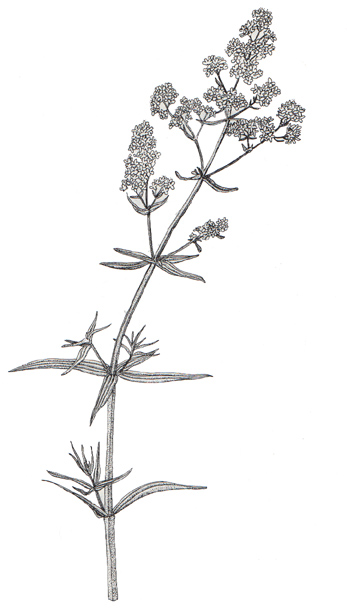

Cleavers
Galium boreale
(Rubiaceae)
Description:
Cleavers, also called lady's bedstraw, baby's breath, or
goosegrass, is distinguished by the arrangement of the leaves on the square,
2-foot (60 cm.) tall, erect stem. Leaves are in a whorl, which means that four
or five of the narrow, smooth-margined, sharp-pointed leaves are attached to
the stem at one spot. A few centimeters farther along the stem occurs another
whorl of leaves. The leaves themselves have three veins and no stem; they are
sessile. The numerous flowers form in loose panicles; each flower has four white
petals. The fruit has hairs. Cleavers belongs to the Madder family, which includes
coffee, quinine, ipecac, gardenia and woodruff.
Distribution:
Galium is distributed in temperate
regions around the world. It is quite common as a garden weed and in the forests.
Constituents:
The plant contains starch, chlorophyll, and three distinct
acids: a kind of tannic acid named galitannic acid, citric acid and rubichloric
acid. It is probably the acid content that is responsible for the plant's property
of curdling milk. The association of this plant with milk is reflected in its
name, Galium, from the Greek word gala, milk, and
the common name of cheese rennet.
Medicinal uses:
Cleavers is a soothing, relaxing diuretic that influences
the kidneys and bladder and acts mildly on the bowels. Cleavers tea, a mild
laxative, is also given for diarrhea--probably due to the astringent effect
of the tannic acid.
One of cleavers' medicinal values, to promote the loss of weight (which seems to take about six weeks), is probably due to the ability of its acids to speed up the metabolism of stored fat.
The plant works best if you gather your own herbs rather than buy them in the herb store. Be forewarned, however--continued use of cleavers tea has caused irritation to the mouth and tongue. To prevent this sort of irritation, a demulcent smoothing ingredient should be added to the formula. Slippery elm and marshmallow root have been used for this purpose.
Cleavers should not be given where there is a tendency toward diabetes.
Since cleavers is a refrigerant herb (Christopher) it would not be indicated for a type of person who is always cold. But, it is good to apply to the face with cotton to cool a sunburn. Euell Gibbons recommends the tea as a lotion on the face to remove freckles and to make the complexion clear.
Simmonite-Culpeper recommend a cleavers decoction to stop inward bleeding and to heal all inward wounds generally.
The Tanaina use cleavers the same way they use wormwood (Artemisia tilesii). Lime villagers say it is especially good as a hot pack for aches and pains. (Kari)
Copyright © 1987 by Eleanor G. Viereck